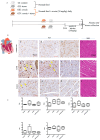Functional Mechanisms of Dietary Crocin Protection in Cardiovascular Models under Oxidative Stress
- PMID: 39065537
- PMCID: PMC11280316
- DOI: 10.3390/pharmaceutics16070840
Functional Mechanisms of Dietary Crocin Protection in Cardiovascular Models under Oxidative Stress
Abstract
It was previously reported that crocin, a water-soluble carotenoid isolated from the Crocus sativus L. (saffron), has protective effects on cardiac cells and may neutralize and even prevent the formation of excess number of free radicals; however, functional mechanisms of crocin activity have been poorly understood. In the present research, we aimed to study the functional mechanism of crocin in the heart exposed to oxidative stress. Accordingly, oxidative stress was modeled in vitro on human umbilical vein endothelial cells (HUVECs) and in vivo in mice using cellular stressors. The beneficial effects of crocin were investigated at cellular and molecular levels in HUVECs and mice hearts. Results indicated that oral administration of crocin could have protective effects on HUVECs. In addition, it protects cardiac cells and significantly inhibits inflammation via modulating molecular signaling pathways TLR4/PTEN/AKT/mTOR/NF-κB and microRNA (miR-21). Here we show that crocin not only acts as a direct free radical scavenger but also modifies the gene expression profiles of HUVECs and protects mice hearts with anti-inflammatory action under oxidative stress.
Keywords: cardiovascular; crocin; dietary antioxidants; microRNA; oxidative stress.
Conflict of interest statement
The authors declare no conflicts of interest.
Figures








Similar articles
-
Crocin molecular signaling pathways at a glance: A comprehensive review.Phytother Res. 2022 Oct;36(10):3859-3884. doi: 10.1002/ptr.7583. Epub 2022 Aug 21. Phytother Res. 2022. PMID: 35989419 Review.
-
Crocin attenuates isoprenaline-induced myocardial fibrosis by targeting TLR4/NF-κB signaling: connecting oxidative stress, inflammation, and apoptosis.Naunyn Schmiedebergs Arch Pharmacol. 2020 Jan;393(1):13-23. doi: 10.1007/s00210-019-01704-4. Epub 2019 Aug 7. Naunyn Schmiedebergs Arch Pharmacol. 2020. PMID: 31392383
-
Crocetin and Its Glycoside Crocin, Two Bioactive Constituents From Crocus sativus L. (Saffron), Differentially Inhibit Angiogenesis by Inhibiting Endothelial Cytoskeleton Organization and Cell Migration Through VEGFR2/SRC/FAK and VEGFR2/MEK/ERK Signaling Pathways.Front Pharmacol. 2021 Apr 30;12:675359. doi: 10.3389/fphar.2021.675359. eCollection 2021. Front Pharmacol. 2021. PMID: 33995106 Free PMC article.
-
Crocin, the main active saffron (Crocus sativus L.) constituent, as a potential candidate to prevent anxiety and depressive-like behaviors induced by unpredictable chronic mild stress.Neurosci Lett. 2022 Nov 20;791:136912. doi: 10.1016/j.neulet.2022.136912. Epub 2022 Oct 13. Neurosci Lett. 2022. PMID: 36244518
-
A Perspective on Crocus sativus L. (Saffron) Constituent Crocin: A Potent Water-Soluble Antioxidant and Potential Therapy for Alzheimer's Disease.J Agric Food Chem. 2017 Feb 8;65(5):1005-1020. doi: 10.1021/acs.jafc.6b04398. Epub 2017 Jan 31. J Agric Food Chem. 2017. PMID: 28098452 Review.
Cited by
-
Carotenoids in Skin Photoaging: Unveiling Protective Effects, Molecular Insights, and Safety and Bioavailability Frontiers.Antioxidants (Basel). 2025 May 11;14(5):577. doi: 10.3390/antiox14050577. Antioxidants (Basel). 2025. PMID: 40427459 Free PMC article. Review.
-
Water-soluble carotenoid: focused on natural carotenoid crocin.Food Sci Biotechnol. 2025 Feb 12;34(5):1119-1138. doi: 10.1007/s10068-025-01832-z. eCollection 2025 Mar. Food Sci Biotechnol. 2025. PMID: 40093551 Review.
References
-
- Krylatov A.V., Maslov L.N., Voronkov N.S., Boshchenko A.A., Popov S.V., Gomez L., Wang H., Jaggi A.S., Downey J.M. Reactive Oxygen Species as Intracellular Signaling Molecules in the Cardiovascular System. Curr. Cardiol. Rev. 2018;14:290–300. doi: 10.2174/1573403X14666180702152436. - DOI - PMC - PubMed
LinkOut - more resources
Full Text Sources
Research Materials
Miscellaneous

